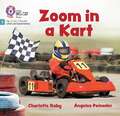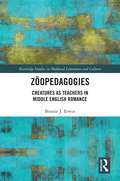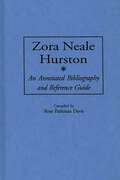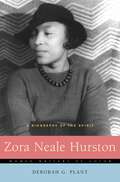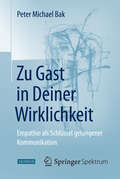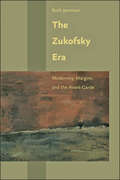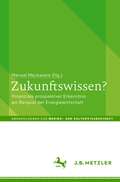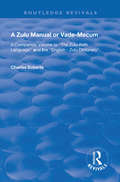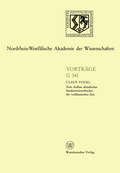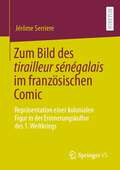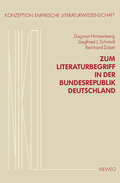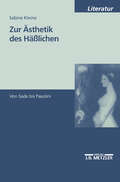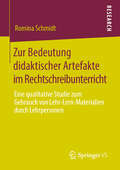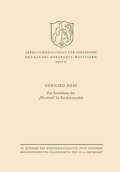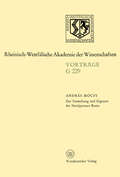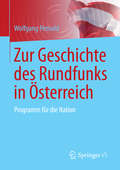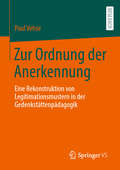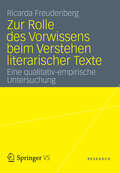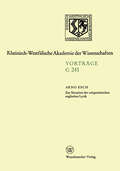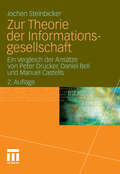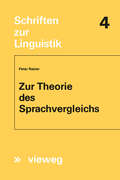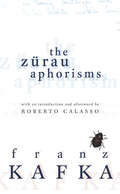- Table View
- List View
Zöopedagogies: Creatures as Teachers in Middle English Romance
by Bonnie J. ErwinThe human protagonists of medieval romance are works in progress. They are learners, taught by an unexpected set of teachers: non-human animals including horses, hawks, lions, and the various quarry of the hunt. These "creature teachers" show humans how to be more perfectly human—how to love, fight, survive, and live according to medieval culture’s highest ideals. Zöopedagogies explores the pedagogical role of animals in medieval romance, a genre whose fantastical elements enable animal characters to behave in ways inspired by, but not limited to their real-world actions. Situated at the intersection of animal studies and medieval studies, Zöopedagogies claims medieval roots for posthumanism by telling a new story about the role of animals in constructing Western culture. Bonnie Erwin brings together a diverse array of texts, including chivalric romances like Sir Gawain and the Green Knight and popular romances like Bevis of Hampton and Richard Coer de Lyon. She puts these into conversation with medieval texts on natural science, horsemanship, hawking, and hunting that inform the representation of creatures who teach. In so doing, she reveals a rich and nuanced sense of animals as participants in interspecies collaborative culture-making.
Zöopedagogies: Creatures as Teachers in Middle English Romance
by Bonnie J. ErwinThe human protagonists of medieval romance are works in progress. They are learners, taught by an unexpected set of teachers: non-human animals including horses, hawks, lions, and the various quarry of the hunt. These "creature teachers" show humans how to be more perfectly human—how to love, fight, survive, and live according to medieval culture’s highest ideals. Zöopedagogies explores the pedagogical role of animals in medieval romance, a genre whose fantastical elements enable animal characters to behave in ways inspired by, but not limited to their real-world actions. Situated at the intersection of animal studies and medieval studies, Zöopedagogies claims medieval roots for posthumanism by telling a new story about the role of animals in constructing Western culture. Bonnie Erwin brings together a diverse array of texts, including chivalric romances like Sir Gawain and the Green Knight and popular romances like Bevis of Hampton and Richard Coer de Lyon. She puts these into conversation with medieval texts on natural science, horsemanship, hawking, and hunting that inform the representation of creatures who teach. In so doing, she reveals a rich and nuanced sense of animals as participants in interspecies collaborative culture-making.
Zora Neale Hurston: An Annotated Bibliography and Reference Guide (Bibliographies and Indexes in Afro-American and African Studies)
by Rose P. DavisZora Neale Hurston (1891-1960) is one of 20th-century America's foremost fiction and folklore writers. Though she was criticized by some of her contemporaries, including Richard Wright and Ralph Ellison, her works are now frequently taught in literature courses and are widely admired for their style and substance. This reference book is a comprehensive guide to the large body of work written about her in the last 75 years. Included are annotated entries for books, dissertations, and theses written about Hurston's life and literary career. The volume also looks at hundreds of articles, book chapters, conference papers, reviews, children's books, and web sites. The bibliography additionally points the reader to guides and biographical sources and to anthologies where her works are collected. Finally, an exhaustive list of works by Hurston is provided, along with a catalog of the special collections where her manuscripts, correspondence, and ephemera are stored.Zora Neale Hurston (1891-1960) is one of 20th-century America's foremost fiction and folklore writers. One of the most important authors of the Harlem Renaissance and one of the first black anthropologists, she received little recognition during her lifetime. She was criticized by some of her contemporaries, including Richard Wright and Ralph Ellison, and her works were largely neglected until the early 1970s. Her works are now frequently taught in literature courses and are widely admired for their style and substance. Her anthropological study,IMules and Men (1935), is a pioneering examination of Voodoo and related folklore. As a novelist, she is best known as the author of Jonah's Gourd Vine (1934) and Their Eyes Were Watching God (1937). In addition, she was a prolific journalist who contributed to the most popular magazines and newspapers of her time.Though long neglected, Hurston has become firmly established in the literary canon, and scores of books and articles have been written about her. This reference book is a comprehensive guide to the large body of work written about her in the last 75 years. Included are annotated entries for books, dissertations, and theses written about Hurston's life and literary career. The volume also looks at hundreds of articles, book chapters, conference papers, reviews, children's books, and web sites. The bibliography additionally points the reader to guides and biographical sources and to anthologies where her works are collected. Finally, an exhaustive list of works by Hurston is provided, along with a catalog of the special collections where her manuscripts, correspondence, and ephemera are stored.
Zora Neale Hurston: A Biography of the Spirit (Women Writers of Color)
by Deborah G. PlantThis new biography takes into account the whole woman—not just the prolific author of such great works as Their Eyes Were Watching God , Moses, Man of the Mountain, Jonah's Gourd Vine, Mules and Men, as well as essays, folklore, short stories, and poetry—but the philosopher and the spiritual soul, examining how each is reflected in her career, fiction and nonfiction publications, social and political activity, and, ultimately, her death.When we ask what animated the woman who achieved all that she did, we must necessarily probe further. Not one of the other existing biographies discusses or analyzes Hurston's spirituality in any sustained sense, even though this spirituality played a significant role in her life and works. As author Deborah G. Plant shows, Zora Neale Hurston's ability to achieve and to endure all she did came from the courage of her convictions—a belief in self that was profoundly centered and anchored in spirituality.
Zu Gast in Deiner Wirklichkeit: Empathie als Schlüssel gelungener Kommunikation
by Peter Michael BakMit Scharfsinn, Humor und auf der Basis neuer wissenschaftlicher Erkenntnisse wird in diesem Sachbuch das alte Thema Kommunikation ganz neu beleuchtet. Das Thema Empathie steht dabei als Voraussetzung erfolgreicher Kommunikation im Mittelpunkt. Was aber ist Empathie ganz konkret? Wie funktioniert sie? Können wir den anderen wirklich verstehen? Wie können wir überhaupt empathisch sein? Gibt es Empathie auch im Internet? Wie hängen Empathie und Moral zusammen? Wie entstehen Konflikte und warum führt Empathie zur Selbsterkenntnis? Psychologieprofessor Peter Michael Bak gibt anhand zahlreicher Beispiele und auf der Grundlage aktueller psychologischer Forschungsergebnisse anregende und teilweise überraschende Antworten auf diese Fragen. Das Buch setzt dabei keinerlei Vor- oder Fachwissen voraus, sondern wendet sich an alle interessierten Leserinnen und Leser, die wissen möchten, warum es überhaupt Missverständnisse gibt und warum das Miteinander reden manchmal so schwierig sein kann. Den Leser erwarten dabei nicht nur interessante Einblicke zur gelingenden Kommunikation, sondern auch spannende Einsichten über sich selbst.
The Zukofsky Era: Modernity, Margins, and the Avant-Garde (Hopkins Studies in Modernism)
by Ruth JennisonInaugurated in 1931 by Louis Zukofsky, Objectivist poetry gave expression to the complex contours of culture and politics in America during the Great Depression. This study of Zukofsky and two others in the Objectivist constellation, George Oppen and Lorine Niedecker, elaborates the dialectic between the formal experimental features of their poetry and their progressive commitments to the radical potentials of modernity.Mixing textual analysis, archival research, and historiography, Ruth Jennison shows how Zukofsky, Oppen, and Niedecker braided their experiences as working-class Jews, political activists, and feminists into radical, canon-challenging poetic forms. Using the tools of critical geography, Jennison offers an account of the relationship between the uneven spatial landscapes of capitalism in crisis and the Objectivists’ paratactical textscapes. In a rethinking of the overall terms in which poetic modernism is described, she identifies and assesses the key characteristics of the Objectivist avant-garde, including its formal recognition of proliferating commodity cultures, its solidarity with global anticapitalist movements, and its imperative to develop poetics that nurtured revolutionary literacy. The resulting narrative is a historically sensitive, thorough, and innovative account of Objectivism’s Depression-era modernism.A rich analysis of American avant-garde poetic forms and politics, The Zukofsky Era convincingly situates Objectivist poetry as a politically radical movement comprising a crucial chapter in American literary history. Scholars and students of modernism will find much to discuss in Jennison’s theoretical study.
The Zukofsky Era: Modernity, Margins, and the Avant-Garde (Hopkins Studies in Modernism)
by Ruth JennisonInaugurated in 1931 by Louis Zukofsky, Objectivist poetry gave expression to the complex contours of culture and politics in America during the Great Depression. This study of Zukofsky and two others in the Objectivist constellation, George Oppen and Lorine Niedecker, elaborates the dialectic between the formal experimental features of their poetry and their progressive commitments to the radical potentials of modernity.Mixing textual analysis, archival research, and historiography, Ruth Jennison shows how Zukofsky, Oppen, and Niedecker braided their experiences as working-class Jews, political activists, and feminists into radical, canon-challenging poetic forms. Using the tools of critical geography, Jennison offers an account of the relationship between the uneven spatial landscapes of capitalism in crisis and the Objectivists’ paratactical textscapes. In a rethinking of the overall terms in which poetic modernism is described, she identifies and assesses the key characteristics of the Objectivist avant-garde, including its formal recognition of proliferating commodity cultures, its solidarity with global anticapitalist movements, and its imperative to develop poetics that nurtured revolutionary literacy. The resulting narrative is a historically sensitive, thorough, and innovative account of Objectivism’s Depression-era modernism.A rich analysis of American avant-garde poetic forms and politics, The Zukofsky Era convincingly situates Objectivist poetry as a politically radical movement comprising a crucial chapter in American literary history. Scholars and students of modernism will find much to discuss in Jennison’s theoretical study.
Zukunftswissen?: Potenziale prospektiver Erkenntnis am Beispiel der Energiewirtschaft (Abhandlungen zur Medien- und Kulturwissenschaft)
by Manuel MackasareVorstellungen von der Zukunft bestimmen das menschliche Handeln. In energiewirtschaftlichen Fragen sind solche Antizipationen besonders relevant: Staaten beschließen Förderprogramme, Unternehmen errichten Kraftwerke, Privatpersonen füllen ihre Öltanks oder ersetzen sie durch Wärmepumpen – stets mit Blick auf ein Morgen, der mitunter trügerisch ist. Kontrovers diskutiert wird, ob es ein Wissen von der Zukunft überhaupt geben und inwieweit es Gegenstand der Wissenschaft sein kann. Die Beiträge dieses Bandes untersuchen Möglichkeit, Methoden und Geltung von Zukunftsentwürfen aus philosophischer, historischer, sozial-, literatur- und medienwissenschaftlicher Perspektive.
A Zulu Manual or Vade-Mecum: A Companion Volume to ''The Zulu-Kafir Language'', And The '' English - Zulu Dictonary''. (Routledge Revivals)
by Charles RobertsPublished in 1900, this book provides a companion volume to the Zulu Kafir Language and the English Zulu Dictionary. Including a dictionary and examples of language structure and grammar, this book makes Zulu accessible to all levels of learner.
A Zulu Manual or Vade-Mecum: A Companion Volume to ''The Zulu-Kafir Language'', And The '' English - Zulu Dictonary''. (Routledge Revivals)
by Charles RobertsPublished in 1900, this book provides a companion volume to the Zulu Kafir Language and the English Zulu Dictionary. Including a dictionary and examples of language structure and grammar, this book makes Zulu accessible to all levels of learner.
Zum Aufbau altindischer Sanskritwörterbücher der vorklassischen Zeit (Nordrhein-Westfälische Akademie der Wissenschaften #341)
by Claus VogelZum Bild des tirailleur sénégalais im französischen Comic: Repräsentation einer kolonialen Figur in der Erinnerungskultur des 1. Weltkriegs
by Jérôme SerriereDie Ausgangsfrage dieser Untersuchung ist, wie sich eine Gesellschaft an den 1. Weltkrieg erinnert und inwiefern sich diese Erinnerung mit der Zeit wandelt. Das Phänomen eines solchen „kollektiven Gedächtnisses“ und die verschiedenen Konzepte von Halbwachs, Nora („lieux de mémoire“), Jan Assmann („kulturelles Gedächtnis“) und Aleida Assmann („Funktions- und Speichergedächtnis“ des kulturellen Gedächtnisses) bilden den theoretischen Rahmen der Arbeit.Das Untersuchungsmedium zur Erforschung der französischen Erinnerungskultur zum 1. Weltkrieg bilden Comics („bande dessinées“), ein in Frankreich etabliertes und nachgefragtes Medium. Im Fokus der Betrachtung steht die Rolle der sogenannten „tirailleurs sénégalais“ in der Erinnerungskultur und wie sich die Kolonialzeit auf ihre Wahrnehmung in der französischen Gesellschaft auswirkte. Unterschieden wird dabei zwischen Tirailleurs als Kolonialsoldaten und der Figur des Tirailleurs als Konstrukt einer vergangenen Kolonialzeit. Den Kern der Arbeit bildet die Analyse zweier ausgewählter Comics. Nach festgelegten Kriterien (Deskription, Authentizität, Darstellung, Beitrag zur Erinnerungskultur) wird hier die Darstellung der Tirailleurs im Comic mit dem Bild der Tirailleurs in der Erinnerungskultur und in der Kolonialzeit verglichen. In den Comics werden aus erinnerungskulturellen Randfiguren und historischen Statisten Hauptfiguren des 1. Weltkriegs und selbstbestimmte Protagonisten postkolonialen Ausmaßes.
Zum Literaturbegriff in der Bundesrepublik Deutschland (Konzeption Empirische Literaturwissenschaft #3/4)
by Dagmar HintzenbergZur Ästhetik des Häßlichen: Von Sade bis Pasolini
by Sabine KleineDer Band spannt einen Bogen von de Sade über die »Schwarze Romantik« bis zum französischen Surrealismus und Pasolinis "Salò o le 120 giornate di Sodoma".
Zur Bedeutung didaktischer Artefakte im Rechtschreibunterricht: Eine qualitative Studie zum Gebrauch von Lehr-Lern-Materialien durch Lehrpersonen
by Romina SchmidtDidaktische Artefakte wie Schulbücher, Lernspiele und Tafelbilder sind wichtige „Mitspieler“ im grundschulischen Rechtschreibunterricht. Die vorliegende Studie von Romina Schmidt untersucht mit Strategien der Grounded-Theory-Methodologie, wie diese am alltäglichen Rechtschreibunterricht beteiligt sind und welcher Rechtschreibunterricht aus ihrer Beteiligung hervorgeht. Das Ergebnis der Untersuchungen sind Bausteine einer empirischen Theorie, die Gebrauchssituationen als „zweistimmiges Zeigen“ beschreibbar machen. Die Analyse verweist u.a. darauf, dass der derzeitige Materialgebrauch bestehende Ungleichheitsordnungen im Rechtschreibunterricht stabilisiert.
Zur Entstehung der „Maximen“ La Rochefoucaulds (Arbeitsgemeinschaft für Forschung des Landes Nordrhein-Westfalen #67)
by Gerhard HessZur Entstehung und Eigenart der Nordgrenzen Roms: 228. Sitzung am 15. Februar 1978 in Düsseldorf (Rheinisch-Westfälische Akademie der Wissenschaften #G 229)
by András MócsyZur Geschichte des Rundfunks in Österreich: Programm für die Nation
by Wolfgang PensoldDas Buch bietet erstmals eine Gesamtschau auf die Geschichte des Österreichischen Rundfunks von den 1920er Jahren bis zur Gegenwart. Es schildert die Entstehung und Entwicklung des Radios ab 1924 und dessen Erweiterung um das Fernsehen ab 1955, und es spannt den Bogen bis zur jüngsten Erweiterung von Radio und Fernsehen um das Internet. Dabei integriert es unterschiedliche Gegenstandsfacetten – technische, politische, ökonomische, soziale und kulturelle – zu einer konsistenten Erzählung. Den roten Faden bildet dabei die Genese der öffentlichen Aufgabenstellung des Rundfunks.
Zur Ordnung der Anerkennung: Eine Rekonstruktion von Legitimationsmustern in der Gedenkstättenpädagogik
by Paul VehsePaul Vehse untersucht Anerkennungsproblematiken, die in der Gedenkstättenpädagogik im Bestreben um ein anerkennendes Gedenken an die Verfolgten des Nationalsozialismus entstehen. In der mit Judith Butler fundierten Studie werden die von Axel Honneth formulierten Anerkennungsformen analytisch gewendet und in zwei ausführlichen Fallstudien die Anerkennungsstrategien der pädagogischen Mitarbeiter rekonstruiert. Die Ausschlüsse und Hierarchisierungen, die diese Strategien produzieren, werden vor dem Hintergrund der gegenwärtigen Anerkennungsordnung eingeordnet und diskutiert. Die Studie liefert einen Beitrag zur Analyse von Anerkennung und formuliert Implikationen für die Gedenkstättenpädagogik.
Zur Rolle des Vorwissens beim Verstehen literarischer Texte: Eine qualitativ-empirische Untersuchung
by Ricarda FreudenbergRicarda Freudenberg untersucht Abiturklausuren in Hinblick auf die Qualität der Wissensanwendung zur Erschließung und zum Vergleich zweier Sonette von Hoffmannswaldau und Brecht. Dabei stehen diese Fragen im Mittelpunkt: Welches Vorwissen war beim Verstehen hilfreich? Worauf sind Probleme beim Textverstehen zurückzuführen? Wie kann Literaturunterricht dazu beitragen, dass SchülerInnen maximalen Gewinn aus den in der Kursstufe erworbenen Wissensbeständen für das Verstehen literarischer Texte beziehen? Die Autorin klärt, ob die SchülerInnen im Deutschunterricht der Sekundarstufe zu kompetenten LeserInnen literarischer Werke ausgebildet worden sind, und zieht Konsequenzen für die Lernsituation, die Textauswahl, die Aufgabenstellung und den Erwartungshorizont.
Zur Situation der zeitgenössischen englischen Lyrik: 237. Sitzung am 21. Februar 1979 in Düsseldorf (Rheinisch-Westfälische Akademie der Wissenschaften #241)
by Arno EschZur Theorie der Informationsgesellschaft: Ein Vergleich der Ansätze von Peter Drucker, Daniel Bell und Manuel Castells
by Jochen SteinbickerBegriffe wie Wissens- und Informationsgesellschaft beherrschen die Diskussion um die Zukunft der Industriegesellschaften. Doch im Gegensatz zur Vollmundigkeit, mit der die Ankunft eines neuen Zeitalters verkündet wird, nehmen sich die Bemühungen um eine analytische Klärung von Begriff und Phänomen eher bescheiden aus. Zu den elaboriertesten Ansätzen gehören heute Manuel Castells' vielbeachtete Studie zur Gesellschaft des Informationszeitalters, Daniell Bells klassisches Konzept der "post-industriellen Gesellschaft" und die vom Managementtheoretiker Peter Drucker konzipierte "Wissensgesellschaft". Das Buch führt in diese drei Konzeptionen ein und liefert eine vergleichende Gegenüberstellung der Ansätze.
The Zurau Aphorisms
by Franz KafkaFranz Kafka spent eight months at his sister's house in Zürau between September 1917 and April 1918, enduring the onset of tuberculosis. Illness paradoxically set him free to write, in a series of philosophical fragments, his settling of accounts with life, marriage, his family, guilt and man's condition. These aphorisms have appeared with minor revisions in various posthumous works since his death in 1924. By chance, Roberto Calasso rediscovered Kafka's two original notebooks in Oxford's Bodleian Library. The notebooks, freshly translated and laid out as Kafka intended, are a distillation of Kafka at his most powerful and enigmatic. This lost jewel provides the reader with a fresh perspective on the work of a genius.
